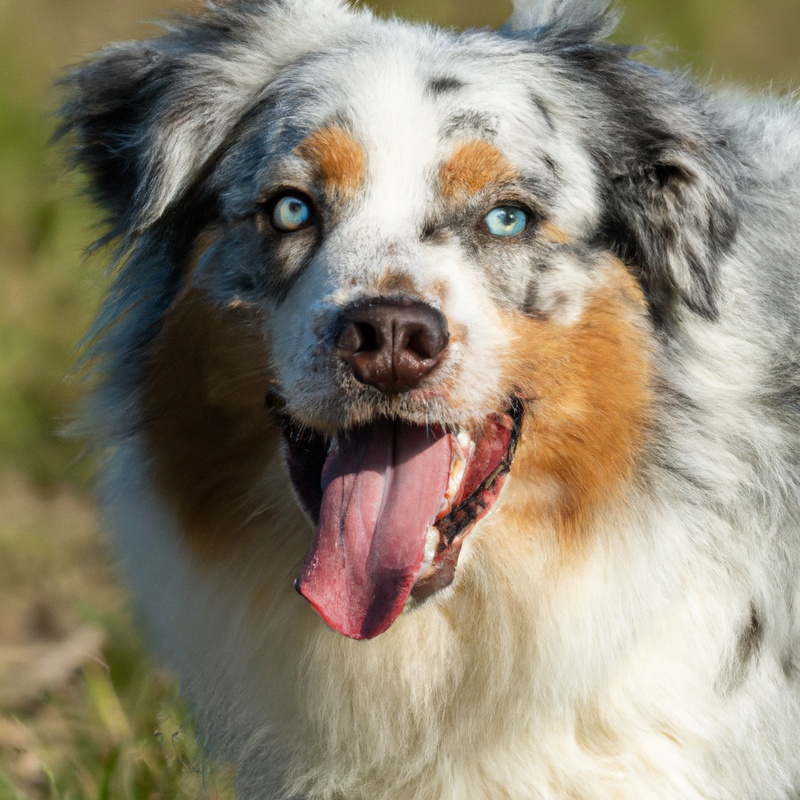How Do Australian Shepherds Behave When Introduced To New Reptiles?
Key Takeaways:
- Australian Shepherds may exhibit curiosity and interest when introduced to new reptiles.
- They might display herding instincts towards reptiles.
- Australian Shepherds generally require proper socialization and training when interacting with reptiles.
- Individual temperament and previous experiences can influence the behavior of Australian Shepherds towards new reptiles.
Are you a reptile lover with an Australian Shepherd by your side? Or perhaps the proud owner of an Australian Shepherd curious about how they react to new scaly companions?
Well, you’ve come to the right place! As a seasoned expert in animal behavior, I’m here to share my insights on how Australian Shepherds behave when introduced to reptiles.
Brace yourself for a wild and fascinating journey as we dive into their instincts, reactions, and the factors that shape their behavior when confronted with these cold-blooded creatures. Plus, I’ll provide you with some invaluable tips on how to ensure a safe and smooth introduction process for both your furry friend and their reptilian counterpart.
Get ready to unravel the mystique behind these incredible dogs and their reptilian encounters!
| Behavior | When Introduced to New Reptiles |
|---|---|
| Affectionate | Australian Shepherds are usually affectionate towards new reptiles. |
| Curious | They typically show curiosity towards new reptiles, wanting to investigate and sniff them. |
| Alert | Australian Shepherds tend to be alert and attentive when encountering new reptiles. |
| Responsive | They are often responsive to reptiles’ movements and behaviors. |
| Cautious | They may exhibit cautious behavior initially, especially if the reptile displays defensive or aggressive actions. |
| Adaptable | With proper introduction and socialization, Australian Shepherds can become more comfortable and adaptable around reptiles. |
Understanding Australian Shepherd Behavior
Australian Shepherds’ Natural Instincts
Australian Shepherds have a strong herding instinct, as they were originally bred to work on farms and ranches. This instinct drives them to round up and control livestock, including cattle, sheep, and even other animals like ducks or chickens.
They have a natural ability to anticipate and react to the movements of animals, which makes them excellent herding dogs.
Another natural instinct of Australian Shepherds is their protective nature. They are known to be loyal and devoted to their families, and this instinct drives them to guard and protect their loved ones.
They are alert and vigilant, always keeping an eye out for any potential threats or intruders.
These dogs also have a strong prey drive, which means they have a natural desire to chase and capture smaller animals. This instinct stems from their herding background, as they would often need to chase and control livestock.
It’s important to be aware of this instinct and provide appropriate outlets for their energy, such as engaging in structured play or participating in dog sports.
In addition, Australian Shepherds are highly intelligent and have a strong work ethic. They thrive on mental and physical stimulation, so it’s crucial to provide them with plenty of mental challenges and physical exercise to prevent boredom and potential behavior issues.
Understanding and respecting these natural instincts is key to effectively train and care for Australian Shepherds.
By channeling their instincts in a positive and controlled manner, you can help them thrive and be well-behaved companions.
How Australian Shepherds React to New Experiences
Australian Shepherds are known for their intelligent and adaptable nature, which makes them open to new experiences. When introduced to new situations or stimuli, such as reptiles, their reactions can vary.
Some Australian Shepherds may approach the experience with curiosity and a desire to investigate, while others may exhibit caution or even anxiety.
It’s important to observe your Australian Shepherd’s body language and behavior when introducing them to new experiences. Signs of acceptance may include a relaxed posture, wagging tail, and a gentle approach towards the reptile.
On the other hand, signs of anxiety may include a raised tail, stiff body, avoidance, or barking.
To ensure a positive experience, it’s recommended to introduce new experiences gradually and in a controlled manner. Start by exposing your Australian Shepherd to the sight or smell of the reptile, then progress to closer interactions over time.
This helps them build confidence and familiarity with the new experience.
Positive reinforcement techniques, such as treats and praise, can also be used to associate the reptile with positive experiences. This can help your Australian Shepherd form positive associations and reduce any fear or anxiety they may initially have.
It’s important to remember that each Australian Shepherd is an individual, and their reactions to new experiences may vary.
Some may be more naturally accepting, while others may require additional time and patience. If you are unsure or concerned about your Australian Shepherd’s behavior, consulting a professional dog trainer or behaviorist can be helpful in providing guidance and support.
Overall, by understanding your Australian Shepherd’s behavior and taking a gradual, positive approach to introducing new experiences, you can help them navigate and adapt to different situations successfully.
Factors Affecting Australian Shepherds’ Behavior
There are several factors that can affect the behavior of Australian Shepherds. One important factor is genetics.
Certain behaviors, such as herding instincts, can be passed down through generations.
Another factor is socialization. Proper socialization from an early age can help Australian Shepherds become well-adjusted and friendly dogs.
Training and obedience also play a role in their behavior.
Consistent training helps Australian Shepherds understand what is expected of them and can prevent behavioral issues. Lastly, the environment they are in can influence their behavior.
A stimulating and enriched environment can keep Australian Shepherds mentally and physically stimulated, reducing the likelihood of destructive or anxious behavior.
So, genetics, socialization, training, and the environment all play a part in shaping the behavior of Australian Shepherds.
Introducing Australian Shepherds to Reptiles
Preparing for the Introduction
Preparing for the introduction of Australian Shepherds to reptiles requires careful planning and consideration. One important step is to research and understand both the behavior of Australian Shepherds and the specific reptile species you will be introducing.
This will help you anticipate any potential challenges or reactions.
Before the introduction, create a safe and controlled environment for both the Australian Shepherd and the reptile. Set up separate areas to ensure the reptile has a secure enclosure, and use baby gates or barriers to maintain a safe distance between the dog and the reptile initially.
Gradually introduce the dog to the reptile by using positive reinforcement techniques.
Start by allowing the dog to observe the reptile from a distance, rewarding calm and relaxed behavior. Gradually decrease the distance over time, always monitoring the dog’s reactions and providing positive reinforcement for appropriate behavior.
Observe the dog’s body language and signs of acceptance or anxiety.
Signs of acceptance may include relaxed body posture, wagging tail, and sniffing without aggression. Signs of anxiety may include raised fur, growling, or attempts to chase or attack the reptile.
If you notice any signs of anxiety or aggression, separate the dog and reptile immediately and consult with a professional trainer or behaviorist for guidance.
Consistency and patience are key during the introduction process. Take it slow and only progress to the next step when both the dog and reptile are comfortable.
It is important to remember that every dog and reptile are individuals, and their reactions may vary.
Always prioritize the safety and well-being of both the dog and the reptile.
Slow and Controlled Introduction Process
When introducing Australian Shepherds to reptiles, it is important to take a slow and controlled approach. Start by allowing your dog to observe the reptile from a distance.
Gradually decrease the distance over time, always monitoring their behavior closely.
Provide positive reinforcement and rewards for calm and relaxed behavior. It’s crucial to create a safe and controlled environment during the introduction process.
Avoid rushing the process and ensure that both your dog and the reptile feel comfortable and secure.
Patience and consistency are key to a successful and harmonious introduction between your Australian Shepherd and a new reptile friend.
Signs of Acceptance or Anxiety in Australian Shepherds
When introducing Australian Shepherds to new reptiles, it’s important to observe their behavior closely for signs of acceptance or anxiety. Here are some key indicators to look out for:
- Body language: An Australian Shepherd showing acceptance will have a relaxed body posture, loose tail wagging, and may approach the reptile with curiosity. On the other hand, anxiety may be evident in a stiff body, tucked tail, avoidance, or trembling.
- Vocalizations: Pay attention to their vocal cues. Acceptance may be indicated by calm or playful vocalizations, while anxiety can manifest through excessive barking, growling, or whining.
- Eye contact: Australian Shepherds showing acceptance will maintain relaxed eye contact with the reptile, possibly with a soft gaze. Anxiety may be expressed through avoidance of eye contact or intense staring.
- Aggression: Keep an eye on their aggression levels. Acceptance is characterized by a lack of aggressive behavior towards the reptile, while anxiety can lead to lunging, snapping, or biting.
- Stress signals: Look out for signs of stress such as excessive panting, pacing, salivating, or excessive shedding. These can indicate anxiety rather than acceptance.
Remember, every dog is unique, and their reactions may vary. Monitoring their behavior closely and seeking professional guidance if needed can help ensure a positive introduction between Australian Shepherds and reptiles.
Building Positive Associations
Building positive associations is key when introducing Australian Shepherds to reptiles. It’s important to create a safe and controlled environment for both the dog and reptile.
Start by allowing the dog to observe the reptile from a distance, rewarding calm behavior with treats and praise.
Gradually decrease the distance between them, always monitoring their reactions. Use positive reinforcement techniques to reinforce calm and relaxed behavior around reptiles.
With patience and consistency, you can help your Australian Shepherd develop a positive association with reptiles.

Common Challenges and Solutions
Aggressive Behavior Towards Reptiles
When it comes to aggressive behavior towards reptiles, Australian Shepherds may display different reactions. Some may show signs of aggression due to their herding instincts or predatory drive.
It’s important to remember that aggression towards reptiles can be dangerous for both the dog and the reptile.
To address this behavior, it is crucial to focus on proper training and socialization from a young age. To start, it’s essential to teach your Australian Shepherd basic commands such as “leave it” and “drop it.” These commands can help redirect their focus away from the reptile and prevent any aggressive behavior.
Socializing your dog with reptiles in a controlled environment can also be beneficial.
Gradually introduce your Australian Shepherd to reptiles, starting with calm and non-threatening species. Monitor their reactions closely and reward them for calm behavior.
If your dog shows signs of aggression, consult with a professional dog trainer or behaviorist for guidance and support.
Engaging your dog in regular exercise and mental stimulation activities can help alleviate their predatory instincts. Providing them with appropriate toys and outlets for their energy can redirect their focus away from reptiles.
Additionally, keeping your Australian Shepherd mentally stimulated through training and environmental enrichment can help prevent boredom and reduce the likelihood of aggressive behavior towards reptiles.
Remember, every dog is unique, and their reactions to reptiles may vary. It’s important to be patient, consistent, and vigilant when introducing your Australian Shepherd to reptiles.
With proper training and socialization, you can help your dog develop a positive and peaceful attitude towards reptiles.

Fear or Anxiety Towards Reptiles
Australian Shepherds may experience fear or anxiety when introduced to new reptiles. This is because of their natural instincts and the unfamiliarity of these creatures.
It is important to understand that each dog may react differently in these situations.
Some Australian Shepherds may show signs of fear, such as trembling or hiding, while others may become anxious and display behaviors like barking or growling. To address fear or anxiety towards reptiles, it’s crucial to provide a gradual and controlled introduction process.
Start by allowing your Australian Shepherd to observe the reptile from a distance and reward them with treats or praise for calm behavior.
Gradually decrease the distance over time, giving them the opportunity to become more comfortable. During this introduction, closely monitor your dog’s body language and behavior.
Signs of acceptance may include relaxed body posture, wagging tail, and curiosity.
On the other hand, signs of anxiety may include raised hackles, tense body, and avoidance behaviors. If your Australian Shepherd shows signs of anxiety, take a step back and give them more time to adjust.
Building positive associations with reptiles is essential in helping your Australian Shepherd overcome their fear or anxiety.
This can be done by incorporating positive experiences, such as feeding treats while the reptile is present or engaging in fun activities near the reptile enclosure. Remember, patience and consistency are key when helping your Australian Shepherd overcome fear or anxiety towards reptiles.
If you’re struggling with this issue, seeking guidance from a professional dog trainer or animal behaviorist can be beneficial in developing a customized plan for your dog’s specific needs.
Overexcitement or Prey Drive Towards Reptiles
Australian Shepherds can sometimes display overexcitement or prey drive when introduced to reptiles. This behavior is rooted in their natural instincts as herding and working dogs.
Their tendency to chase, stalk, and attempt to capture small animals is ingrained in their DNA.
When confronted with reptiles, such as snakes or lizards, Australian Shepherds may become highly aroused and exhibit intense focus on the reptile. To address this behavior, it is essential to provide controlled and supervised introductions.
Slowly exposing the Australian Shepherd to the reptile in a controlled environment allows them to become familiar with the reptile’s presence without triggering their prey drive.
This process helps the dog develop a more measured and less reactive response. It’s important to watch for signs of overexcitement or prey drive in Australian Shepherds when introducing them to reptiles.
These signs may include intense staring, lunging, barking, or displaying heightened energy levels.
If the Australian Shepherd exhibits these behaviors, it’s wise to redirect their attention and engage them in an alternative activity or command, such as a recall or a “leave it” command. Building positive associations with reptiles can also be beneficial.
For example, offering treats or rewards when the Australian Shepherd displays calm and relaxed behavior around reptiles helps reinforce positive experiences.
This positive reinforcement helps the dog associate reptiles with positive outcomes rather than triggering their overexcitement or prey drive. If the overexcitement or prey drive towards reptiles persists or becomes problematic, seeking professional assistance from a qualified dog trainer or behaviorist is recommended.
They can provide specialized guidance and training techniques tailored to address this specific behavior.
Remember, each Australian Shepherd may respond differently to reptiles, so it’s essential to observe and understand your individual dog’s behavior and adjust the introduction process accordingly.
Training Techniques and Professional Assistance
When it comes to training Australian Shepherds to behave around reptiles, there are a few techniques you can try. One approach is gradual exposure, where you introduce your dog to reptiles in a controlled environment.
Start with reptile toys or pictures, then move on to live reptiles in a safe enclosure.
Reward your dog for calm and appropriate behavior. Another technique is desensitization and counter-conditioning.
This involves gradually exposing your dog to the sight, sound, and smell of reptiles while simultaneously providing positive associations, such as treats or play.
The goal is to change your dog’s emotional response from fear or excitement to a more neutral or positive one. If you’re unsure about training on your own, professional assistance can be helpful.
A professional dog trainer or behaviorist can assess your dog’s behavior and provide tailored training techniques.
They can also guide you through the process and address any specific challenges you may encounter. It’s important to remember that every dog is different, so what works for one Australian Shepherd may not work for another.
Patience, consistency, and positive reinforcement are key.
With the right training techniques and professional assistance, you can help your Australian Shepherd behave appropriately around reptiles.
Safety Precautions for Australian Shepherds and Reptiles
Supervision and Containment Measures
When it comes to introducing Australian Shepherds to reptiles, proper supervision and containment measures are crucial. Here are some tips to ensure the safety of both your dog and the reptile:
- Supervision is key: Always supervise your Australian Shepherd when they are around reptiles. This means keeping a watchful eye on their interactions and being ready to intervene if necessary.
- Separate spaces: If you have reptiles in your home, make sure to create separate spaces for them and your dog. Use sturdy enclosures or cages that are escape-proof for the reptiles, and ensure they are elevated or out of reach of your dog.
- Secure the environment: Take steps to secure the environment to prevent any accidents or escapes. This can include using baby gates or barriers to separate areas, ensuring doors and windows are secure, and removing any potential hazards or items that could harm either your dog or the reptile.
- Training and obedience: Ensure that your Australian Shepherd is well-trained and obedient before introducing them to reptiles. Teaching them basic commands such as “leave it” or “stay” can be helpful in managing their behavior around the reptiles.
- Gradual introductions: Start with slow and controlled introductions between your dog and the reptile. Keep them at a safe distance initially and gradually decrease the distance over time, always monitoring their behavior for signs of acceptance or anxiety.
Creating a Safe Environment for Both
When it comes to creating a safe environment for both Australian Shepherds and reptiles, there are a few important factors to consider. First, it’s crucial to provide separate spaces for each.
This ensures that they have their own territory and reduces the risk of any potential conflicts.
Additionally, make sure to secure enclosures and barriers to prevent any accidental contact between them. Another important aspect is to educate yourself about the specific needs and behaviors of both Australian Shepherds and reptiles.
This includes understanding their natural instincts and how they may react in certain situations.
By having this knowledge, you can better anticipate and address any potential issues that may arise. Regular monitoring and supervision are key to maintaining a safe environment.
Keep a close eye on both your Australian Shepherd and the reptiles to ensure their well-being.
This also helps you quickly identify any signs of stress, anxiety, or aggression and take appropriate measures to address them. Lastly, it’s important to provide enrichment and stimuli for both Australian Shepherds and reptiles.
This can include mental and physical activities to keep them engaged and fulfilled.
By meeting their needs, you can help to reduce any potential boredom or frustration that may lead to negative behaviors. By creating a safe environment for both Australian Shepherds and reptiles, you can ensure their well-being and promote a harmonious coexistence.
Remember to always prioritize their safety and provide the necessary measures to prevent any accidents or conflicts.
Educating and Monitoring Children Around Reptiles
When it comes to educating and monitoring children around reptiles, safety is the top priority. It’s important to teach children about the potential risks and precautions associated with interacting with reptiles.
Start by explaining to children that reptiles are not toys and should be treated with respect.
Teach them how to safely handle reptiles, emphasizing the importance of gentle and calm interactions. Supervision is crucial when children are around reptiles to ensure their safety and the well-being of the reptiles.
Make sure children understand that reptiles have specific needs and should be left alone when they are eating, shedding, or showing signs of stress.
By educating and monitoring children, we can create a safe environment for both children and reptiles.
Final Verdict
Introducing Australian Shepherds to new reptiles requires careful preparation, a slow and controlled introduction process, and the ability to identify signs of acceptance or anxiety in the dog. It is important to build positive associations and create a safe environment for both the dog and the reptile.
While some Australian Shepherds may exhibit aggressive behavior, fear, or overexcitement towards reptiles, these challenges can be addressed through training techniques and professional assistance if needed.
Overall, with the right approach and precautions, Australian Shepherds can learn to coexist peacefully with reptiles. Trust the information shared here to successfully introduce your Australian Shepherd to reptiles and ensure a harmonious cohabitation.







